Olympiastadion (Berlin): Difference between revisions
m Reverted edits by 131.165.149.33 (talk) to last revision by ClueBot NG (HG) |
Tag: possible vandalism |
||
| Line 62: | Line 62: | ||
====Bell Tower==== |
====Bell Tower==== |
||
Hej jeg kan lide milfs og gilf. Jacob kan lide diller saft. Du ser godt ud! |
|||
The Bell Tower crowned the western end of the Reichs Sportfield planted amid the tiers of the Maifeld stands. It was 77 metres (247 ft) high. From its peak could be observed the whole city of Berlin. During the games, it was used as observation post by administrators and police officials, doctors and the media. |
The Bell Tower crowned the western end of the Reichs Sportfield planted amid the tiers of the Maifeld stands. It was 77 metres (247 ft) high. From its peak could be observed the whole city of Berlin. During the games, it was used as observation post by administrators and police officials, doctors and the media. |
||
[[File:1936 Olympics Bell - Berlin.jpg|thumb|left|The Olympic Bell in 1993]] |
[[File:1936 Olympics Bell - Berlin.jpg|thumb|left|The Olympic Bell in 1993]] |
||
Revision as of 11:54, 30 April 2013
 | |
 | |
| Full name | Berlin Olympiastadion |
|---|---|
| Former names | Deutsches Stadion |
| Location | Westend, Charlottenburg-Wilmersdorf, Berlin, Germany |
| Coordinates | 52°30′53″N 13°14′22″E / 52.51472°N 13.23944°E |
| Owner | Olympiastadion Berlin GmbH |
| Operator | WALTER BAU-AG/DYWIDAG |
| Capacity | 74,064[1] |
| Field size | 105 x 68 m |
| Surface | Grass |
| Construction | |
| Built | 1934 to 1936 |
| Opened | 1936 |
| Renovated | 1974 (Reconfiguration) 2006 (World Cup) |
| Construction cost | 43 million RM (1936) €247 million (2004) |
| Architect | Werner March/ Albert Speer (1936) Friedrich Wilhelm Krahe (1974) |
| Tenants | |
| Hertha BSC (2. Bundesliga) (1963–present) 1936 Summer Olympics FIFA World Cup (1974, 2006) Berlin Thunder (NFL Europa) (2004–2007) 2009 World Championships in Athletics 2011 FIFA Women's World Cup | |
The Olympiastadion (Olympic Stadium) is a sports stadium in Berlin, Germany. There have been two stadia on the site: the present facility, and one that is called the Deutsches Stadion which was built for the aborted 1916 Summer Olympics. Both were designed by members of the same family, the first by Otto March and the second by his son Werner March. It is the second biggest stadium in Germany behind Signal Iduna Park. It is the home stadium of the Hertha Berlin football team playing in the German 2. Bundesliga.
The current Olympiastadion was originally built for the 1936 Summer Olympics in the southern part of the Reichssportfeld (today Olympiapark Berlin). During World War II, the area suffered little damage. After the war, the British military occupation used the northern part of the Reichssportfeld as its headquarters until 1949. From 1951 to 2005, the Olympischer Platz had a giant antenna transmitting for all the portable radios in Berlin.
Aside from its use as an Olympic stadium, the Olympiastadion has a strong footballing tradition. Historically, it is the ground of club Hertha BSC since 1963. It was also used for 3 matches in the 1974 FIFA World Cup. It hosted six matches, including the final, in the 2006 FIFA World Cup and was renovated for that reason. The German Cup final match is held each year at the Olympiastadion. The stadium sees use in other sports as well; at one point it held the world record for the attendance of a baseball game, thought to be over 110,000.
History
1916 to 1934: Deutsches Stadion, old Olympiastadion
During the 1912 Summer Olympics, the city of Berlin was designated by the International Olympic Committee (IOC) to host the 1916 Summer Olympics. Germany's proposed stadium for this event was to be located in Charlottenburg, in the Grunewald Forest, to the west of Berlin—thus the stadium was also known as Grunewaldstadion. A horse racing-course already existed there which belonged to the Berliner Rennverein, and even today the old ticket booths survive on Jesse-Owens-Allee. The government of Germany decided not to build in the nearby Grunewald forest, or to renovate buildings that already existed. Because of this desire, they hired the same architect who originally had built the "Rennverein", Otto March.
March decided to bury the stadium in the ground ("Erdstadion", in German). However, the 1916 Olympic Games were cancelled due to World War I. In the 1920s the first buildings of a school, the "Deutsches Sportforum" (German Sport Forum), dedicated to the teaching of professors of physical education and the study of sport science were built northeast of the stadium site. From 1926 to 1929, Otto March's sons (Werner and Walter) were assigned to build an annex for these institutions, though the finalization was delayed until 1936.
1936: Reichssportfeld
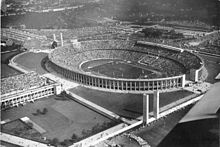
In 1931, the International Olympic Committee made Berlin the host city of the 11th Summer Olympics. Originally, the German government decided merely to restore the earlier Olympiastadion (German Stadium) of 1916, with Werner March again retained to do this.
When the Nazis came to power in Germany (1933), they decided to use the Olympic Games in 1936 for propaganda purposes. With these plans in mind, Hitler ordered the construction of a great sports complex in Grunewald named the "Reichssportfeld" with a totally new Olympiastadion. Architect Werner March remained in charge of the project, assisted by his brother Walter March.
Construction took place from 1934 to 1936. When the Reichssportfeld was finished, it was 1.32 square kilometres (326 acres). It consisted of (east to west): the Olympiastadion, the Maifeld (Mayfield, capacity of 50,000) and the Waldbühne amphitheater (capacity of 25,000), in addition to various places, buildings and facilities for different sports (such as football/soccer, swimming, equestrian events, and field hockey) in the northern part.
Olympiastadion

Werner March built the new Olympiastadion on the foundation of the original Deutsches Stadion, once again with the lower half of the structure buried 12 meters underground.
The capacity of the Olympiastadion reached 110,000 spectators. It also possessed a special stand for Adolf Hitler and his political associates. At its end, aligned with the symmetrically-designed layout of the buildings of the Olympischer Platz and toward the Maifeld, was the Marathon Gate with a big receptacle for the Olympic Flame.
To the east of the stadium, there were two field hockey stadia that hosted the competitions that were won by India.
Maifeld
Maifeld (Mayfield) was created as a huge lawn (112,000 square metres, 28 acres) for gymnastic demonstrations, specifically annual May Day celebrations by Hitler's government.
Maifeld was surrounded by 19 metres of land elevation (62 ft), even though the Olympiastadion (to the east) was only 17 metres (55 ft) high.
The total capacity was 250,000 people, with 60,000 in the large stands that extended at the west end. Also located there were the Langemarck-Halle (below) and the Bell Tower (rising high). The walls were built with sturdy stone from the area of the Lower Alps, and also feature equine sculptures (work of Josef Wackerle).
During the 1936 Olympics, the Maifeld was used for polo and equestrian dressage events.
After World War II the British military occupation forces (Berlin Infantry Brigade) annually celebrated The Queen's Official Birthday on the Maifeld and used it for a variety of sporting activities including Cricket. Starting in 2012, Maifeld became home to the Berlin Cricket Club.[2]
Bell Tower
Hej jeg kan lide milfs og gilf. Jacob kan lide diller saft. Du ser godt ud! The Bell Tower crowned the western end of the Reichs Sportfield planted amid the tiers of the Maifeld stands. It was 77 metres (247 ft) high. From its peak could be observed the whole city of Berlin. During the games, it was used as observation post by administrators and police officials, doctors and the media.
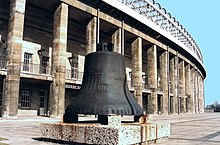
In the tower was the Olympic Bell. On its surface were the Olympic Rings with an eagle, the year 1936, the Brandenburg Gate, the date 1.-16. August and a motto between two swastikas: I call the youth of the world[3] and 11. Olympic Games Berlin – although the games were the 10th (Summer) Olympics, they were the Games of the XI Olympiad.
The Bell Tower was the only part of the Reichssportfeld that was destroyed in the war. The Third Reich used the tower's structure to store archives (such as films). The Soviet troops set its contents on fire, turning the tower into a makeshift chimney. The structure emerged from the fire severely damaged and weakened.
In 1947, the British engineers demolished the tower, however reconstructed it faithfully in 1962. The Olympic Bell (which had survived the fire and remained in its place in the tower) fell 77 metres and cracked and has been unable to sound since then. In 1956, the bell was rescued, only in order to be used as a practice target for shooting with anti-tank ammunition. The old bell survives to this day and serves now as a memorial.
The restoration of the tower was carried out from 1960 to 1962, once again by the architect Werner March, following the original blueprints. The present tower became an important tourist destination offering a panorama of Berlin, Spandau, the Havel Valley, Potsdam, Nauen and Hennigsdorf.
The Langemarck-Halle
This consisted of huge halls built under the stands of the Maifeld. Pillars were raised on which hung flags and shields commemorating all the forces that participated in a battle fought in Langemark (West Flanders, Belgium) on November 10, 1914, during the First World War. Since 2006, the ground floor is home to a public exhibit providing historical information on the area of the former Reichssportfeld.
Waldbühne, the Forest Theatre

The Waldbühne was built in 1936 as part of the preparation for the Berlin Olympics. The tarraces were molded into the glacial river banks of the Berlin glacial valley. It is a reproduction of the old theater of Epidaurus (3rd century BC). The theater was then named "Dietrich-Eckart-Bühne" in homage to Dietrich Eckart.[citation needed]
Seating for up to 25,000 spectators goes down to a depth of 30 metres (97 ft);[4] in the middle section Adolf Hitler's box once stood.[citation needed] The surroundings were decorated with statues by Adolf Wamper. During the Olympics, gymnastics competitions and a myriad of cultural programs were staged in the Waldbühne.
Today, it is used as one of Europe's biggest concert venues. The Berlin Philharmonic has staged the Waldbühne concert in June every year since 1984. Since 2009, its operator has been CTS Eventim.
The pop rock singer P!nk performed on June 8,2010 during The Funhouse Summer Carnival.
Berlin, 1936 Summer Olympics

On August 1, 1936, the Olympics were officially inaugurated by the head of state Adolf Hitler, and the Olympic Flame was lit by the athlete Fritz Schilgen.
While the Olympic Flame had been used for the first time in Amsterdam 1928, in Berlin 1936 a marathon-like tour of the Olympic Torch was introduced, from Olympia in Greece, crossing six frontiers with a journey of 3000 km to Berlin, through Greece, Bulgaria, Yugoslavia, Hungary, Czechoslovakia, Austria and Germany. The original idea of this Olympic torch relay was Carl Diem's, who was a notorious political advisor to Nazi Propaganda Minister Joseph Goebbels, specialising in Olympic affairs.
Four million tickets were sold for all the events of the 1936 Summer Olympics. This was also the first Olympics with television transmission (25 giant screens were scattered all over Berlin) and radio transmissions in 28 languages (with 20 radio vans and 300 microphones).
Among the sport competitions, one of the most memorable events was the performance of the African-American track and field athlete Jesse Owens, representing the United States of America. Owens won the gold medal in the 100, 200, long jump and 4 x 100 relay.
During those games, they also hosted the equestrian jumping, football, and handball events.
The 1936 Olympics held in the stadium were immortalised in the film Olympia (1938) by Leni Riefenstahl.
1939 to 1945: World War II
The Olympiastadion was one of the few buildings that survived not just in a recognisable form, but almost untouched after the Second World War. It only suffered the impact of machine gun shots.
The most significant battle around the Olympiastadion was in April 1945 when the Soviet army fought to capture it. This was during the great final battle of the Second World War in Europe, with the total invasion of Berlin as the Allies' target.
1945 to 1994: Occupied Berlin
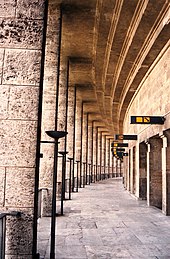
After the war, the former Reichssportfeld became the headquarters of the British military occupation forces.
The British forces settled in the northeastern buildings designed by the March brothers in the 1920s, which the Third Reich had used for official sport organisations such as the Reich Academy of Physical Training and extended by 1936, adding the "Haus des deutschen Sports" (House of German Sports) and other buildings. Soon, the British forces renovated war-damaged buildings but also converted interiors to their specific needs (one gymnasium was converted into a dining hall, another into a garage). From then until 1994 and their departure, British forces held an annual celebration of The Queen's Official Birthday in the Maifeld with thousands of spectators from Berlin present. During the 1960s, American military and high school football teams introduced hundreds of thousands of Berliners to American football at the stadium in exhibition games.
During those years, Bundesliga (football) matches were played in the Olympiastadion, with Hertha BSC as local team. In the Maifeld, several competitions of football, rugby and polo were staged too. In the summers, the Waldbühne resumed its classical music concerts, and playing movies. The theatre was also used as an improvised ring for boxing matches.
Hertha BSC
In 1963, the Bundesliga was formed, and Hertha BSC participated by direct invitation, leaving its old stadium (the "Plumpe") to use the Olympiastadion. On August 24, it played the first local match against FC Nuremberg, with the final score 1:1. However, in 1965, the German Football Association found Hertha BSC guilty of bribery and relegated them to the Regional Leagues. Hertha had illegally bribed several football players in an attempt to add them to the team, following their disinterest in playing in Berlin because of the construction of the Berlin Wall (1961). In 1968, Hertha returned to the first division, and to the Olympiastadion, and in 1971 sold "Plumpe". The second half of 1970s was quite successful for Hertha BSC Berlin. In 1979, it reached the semifinals of the UEFA Cup, but was defeated by Red Star Belgrade. Hertha reached the finals of the German Cup twice (1977 and 1979).
In the 1980s, Hertha had a declining role in the Bundesliga, and fell to the Regional Leagues in 1986, although they later recovered reaching the Second Division (1988–1989).
With the demolition of the Berlin Wall in November 1989, a spontaneous feeling of sympathy between Hertha and FC Union from Eastern Berlin arose, which culminated in a friendly match at the Olympiastadion with 50,000 spectators (January 27, 1990).
In 1990, Hertha returned to the First Division, although it fell again to the Second Division from 1991 until 1997.
Since 1997, the club has improved greatly, climbing up the Bundesliga table and qualifying for the UEFA Champions League, with matches against top European teams like Chelsea and A.C. Milan, increasing the international prestige of the club.
1974 FIFA World Cup
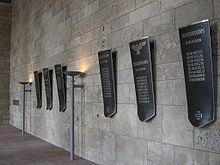
Some matches of Group A (West Germany, Chile, East Germany and Australia) of the 1974 FIFA World Cup were played in the Olympiastadion. The third match, Australia vs Chile, was played in torrential rain. The hosts, West Germany, won the tournament.
| Date | Team #1 | Result | Team #2 | Round |
|---|---|---|---|---|
| 1974-06-14 | 1-0 | Second Round, Group A | ||
| 1974-06-18 | 1-1 | Second Round, Group A | ||
| 1974-06-22 | 0-0 | Second Round, Group A |
| Team | Pts | Pld | W | D | L | GF | GA | GD |
|---|---|---|---|---|---|---|---|---|
| 5 | 3 | 2 | 1 | 0 | 4 | 1 | 3 | |
| 4 | 3 | 2 | 0 | 1 | 4 | 1 | 3 | |
| 2 | 3 | 0 | 2 | 1 | 1 | 2 | −1 | |
| 1 | 3 | 0 | 1 | 2 | 0 | 5 | −5 |
1994 to 2005
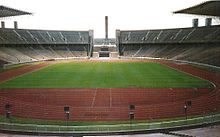
In 1998, Berliners debated the destiny of the Olympiastadion in light of the legacy it represented for Germany.
Some wanted to tear the stadium down and build a new one from scratch, while others favoured letting it slowly crumble "like the Colosseum in Rome".[5]
Finally, it was decided to renovate the Olympiastadion. FIFA then chose it as one of the venues of the 2006 FIFA World Cup. The State of Berlin hired a consortium composed of Walter Bau AG and DYWIDAG that won the €45 million franchise. The consortium took charge of the operation of the facilities together with Hertha BSC and the Government of Berlin after the remodelling.
On July 3, 2000, the renovation began with a ceremony presided over by the Chancellor Gerhard Schröder, accompanied by Eberhard Diepgen (Berlin Mayor), Franz Beckenbauer and Prof. Dr. Ignaz Walter.
The Reconstruction
70,000 cubic metres (92,000 yd3) of concrete and 20,000 cubic metres (26,000 yd3) of pre-cast reinforced concrete elements were used. 12,000 cubic metres (16,000 yd3) of concrete was demolished and removed and 30,000 cubic metres (39,000 yd3) of natural stone was refurbished.
The roof was extended to cover a total of 37,000 square metres, with 20 roof-supporting columns carrying a weight of 3,500 tonnes of steel.
With the intention of creating a more intimate atmosphere for football games, the playing field was lowered (even more) by 2.65 metres (8.7 ft); approximately 90,000 cubic metres (120,000 yd3) of sand was excavated. The lower tier of seating in the stadium was demolished and rebuilt at a completely different angle of inclination.
The conservation factor of the Olympiastadion as a historical monument was also considered, especially with respect to the preservation of the natural stone blocks. After criticisms, the colour of the athletics track around the game field was changed from red to blue, reflecting the colours of Hertha BSC.
On January 9, 2002, construction workers found an unexploded World War II bomb buried beneath a section of seating. It was defused outside the stadium by Berlin police.[6]
Technical details
The new Olympic Stadium has the highest all-seated capacity in Germany at 74,500. The only stadium to have more total capacity is Dortmund's Signal Iduna Park (formerly Westfalenstadion) (though the Westfalenstadion has both seating and standing areas, and its all seated capacity of 65,718 is lower than the Olympiastadion).
The roof rises 68 metres over the seats and is made up of transparent panels that allow sunlight to stream in during the day. The western portion (on the Marathon Arch) is open to reveal the Bell Tower to the spectators.
The Olympiastadion was equipped with the latest technology in artificial illumination and sound equipment. It has 113 VIP stands, a set of restaurants, and two underground garages (for 630 cars).
The total cost of the remodelling and amplification was €242 million.
Reinauguration and post-reinauguration
The reinauguration celebrations of the new Olympic Stadium were carried out on July 31, 2004 and August 1, 2004. On that day, Saturday, the party began with performances from P!nk, Nena and Daniel Barenboim. It culminated at night with the opening ceremony.
On day two, friendly matches were played between different categories of the club Hertha BSC and visiting teams. On September 8, 2004, Brazil played Germany.
Current tenants
The stadium is currently used as the home venue for the Fußball-Bundesliga's Hertha BSC. Since 1985, the stadium has hosted the finals of both the DFB-Pokal and its companion women's tournament, the Frauen DFB Pokal. However, it did not host the 2010 final of the Frauen DFB Pokal, which was held at Cologne's RheinEnergieStadion as part of an experimental test to host the event in a different city. The stadium also hosts the Internationales Stadionfest, which also served as an IAAF Golden League event until 2010, it is currently unknown if it will be a part of the new IAAF Diamond League.
The stadium also served as home to the Berlin Thunder, an American football team in NFL Europa, until the league's operator, the U.S. National Football League, closed down the money-losing competition in 2007.
The stadium was a possible venue for the 2011 UEFA Champions League Final, along with the Allianz Arena in Munich before Wembley Stadium in London was decided as the venue in January 2009.
FIFA World Cup 2006
This was the location of the World Cup final between France and Italy and the site of Zinedine Zidane's infamous headbutt.
Scheduled matches
| Date | Time (CEST) | Team #1 | Result | Team #2 | Round | Spectators |
|---|---|---|---|---|---|---|
| 13 June 2006 | 72,000 | |||||
| 15 June 2006 | 72,000 | |||||
| 20 June 2006 | 72,000 | |||||
| 23 June 2006 | 72,000 | |||||
| 30 June 2006 | 72,000 | |||||
| 9 July 2006 | 72,000 |
Political considerations
The Olympiastadion was designated to play the final match of the 2006 FIFA World Cup. This took place exactly 70 years after the 1936 Summer Olympics.
Peter Steinhorst, chief technician on the project, said to the BBC: "Whenever you enter, you will still know this was the site of the 1936 Games. You will pass all the old Nazi sculptures".[5]
"The history is there, the totality of the buildings is there. The whole Nazi landscape has not disappeared", added the sports sociologist Günther Gebauer. "There are towers like in a fortress, and people who come will always ask where the Führer sat.".[5]
Germany's Interior Minister Otto Schily, who attended the opening party, concluded: "The stadium recalls the dark elements present in its creation. But in 2006 the world will look upon to modern, democratic, and open Germany".[5]
Other uses
Concerts
The stadium has been used for pop, rock and electronic concerts.
Australian rock band AC/DC performed at the stadium in 2010.
British rock band Genesis performed at the stadium in 2007.
German rock artist Herbert Groenemeyer performed at the stadium in 2007, 2008 and 2011.
American rock band Guns N' Roses performed at the stadium in 1992.
American pop artist Madonna performed at the stadium in 2008.
American pop artist Michael Jackson performed at the stadium in 1997.
English rock band The Rolling Stones performed at the stadium in 1982, 1990, 1995, 1998, 2003 and 2006.
American soul artist Tina Turner performed at the stadium in 2000.
Canadian pop artist Celine Dion performed at the stadium in 2008.
Irish rock band U2 performed at the stadium three times. The first was on June 15, 1993 during their ZooTV Tour, the second was on July 7, 2005 during the Vertigo Tour in front of a sold out crowd of 70,443 people and the third was on July 18, 2009 during the U2360° Tour in front of a sold out crowd of 88,265 people.
English electronic band Depeche Mode performed at the stadium on June 10, 2009 during their Tour of the Universe in front of a sold out crowd of 65,657 people. They will perform at the stadium for the second time on June 9, 2013 as part of their upcoming The Delta Machine Tour. The 2009 show was recorded for their live albums project Recording the Universe.
American rock artist Bruce Springsteen performed at the stadium in 2012.
American rock band Bon Jovi will perform at the stadium on June 18, 2013 as part of their ongoing Because We Can - The Tour.
Literature
Audiobook
"Olympic Stadium Berlin" by Andreas Janowski. Published by Andreas Janowski Verlag under the label "sights-on-audio" www.sights-on-audio.com
References
- ^ http://www.olympiastadion-berlin.de/en/stadium-visitor-centre/facts-and-figures.html
- ^ Muir, Fabian (12 May 2012). "The past was war, the future is cricket". Cricinfo Magazine. Retrieved 12 May 2012.
- ^ Olympic Games Berlin 1936 – The emblem International Olympic Committee
- ^ Open Air Movie Theater in Berlin Seats 25,000 Spectators." Popular Mechanics, June 1956, p. 131.
- ^ a b c d "New future for Nazi stadium". BBC. 31 July 2004. Retrieved 2008-08-27.
- ^ "WW II bomb in Berlin stadium". BBC. 9 January 2002. p. 1. Retrieved 2008-08-27.
- 1936 Summer Olympics official report. Volume 1. pp. 141–9, 154–62.
External links
- Official Olympiastadion Site
- Picture galleries: An illustrative walk along the facilities of the Olympischer Platz.
- Hertha BSC official website
- 1936 Summer Olympic venues
- Olympic athletics venues
- Olympic equestrian venues
- Olympic field hockey venues
- Olympic football venues
- Olympic gymnastics venues
- Olympic handball venues
- Nazi architecture
- Athletics (track and field) venues in Germany
- Olympic stadiums
- American football venues in Germany
- Buildings and structures in Charlottenburg-Wilmersdorf
- Sports venues in Berlin
- 1974 FIFA World Cup stadiums
- 2006 FIFA World Cup stadiums
- Football venues in Germany
- Football venues in East Germany
- Athletics (track and field) venues in East Germany
- Hertha BSC
- 2009 World Championships in Athletics
- American Bowl venues
- 2011 FIFA Women's World Cup







